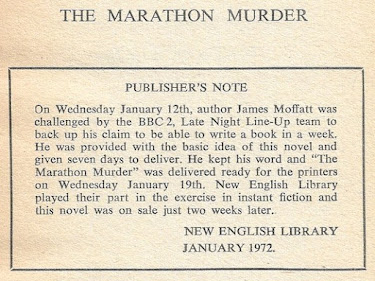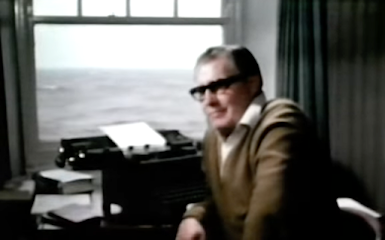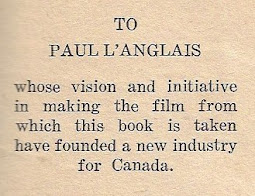Paul Champagne
Winnipeg: Greywood, 1967
190 pages
The Canadian Government has reason to believe there is a vast conspiracy working to sabotage Expo 67. This being the summer '66 and James Bond being all the rage, stylish Serville Gart is brought in expose and defeat the villains. After all, why send in a team when, as Hollywood has shown, the right man can readily handle the job himself. As newly-minted Secret Service Agent 18 dash 67 (irritatingly, never simply "18-67"), Gart receives his assignment in a Privy Council Chamber meeting attended by various government ministers, Quebec government officials, the Mayor of Montreal, and Expo's Commissioner General.
Why Serville Gart?
Well, to begin with the man served in the Canadian Army Special Services and earned a Victoria Cross during the Korean War in rescuing fallen comrades and "single-handedly grenading a North Korean pillbox." A university swimming and wrestling champ, he was scouted by both CFL and NHL teams and once declined a hockey scholarship offered by an American college. Lest you dismiss Gart as all braun and no brain, he is also a chess master and accomplished pianist with two scholarly books to his name.
From the start, it's clear that Gart has the goods. During the Privy Council Chamber meeting he notes something suspicious about an attache case carried by a man named Conrad, aide to the Minster of Finance. Minutes later, Conrad, who has proven himself a baddie, is lying dead with a broken neck in his Centre Block office. Conrad's innocent teenage secretary suffered a bullet to the shoulder, and is whisked off the Ottawa Civic Hospital. Our hero follows:
Gart's TR4 sped off Parliament Hill to Wellington Street. He was not sure which route would be quickest to the Civic Hospital. Some roads had been torn up by construction while others had been patched so often that they resembled backwoods hunting trails. He wondered if the Nation's Capital would ever do anything about them.
He decided to take Wellington, then south on Bronson. He would turn left on to six-lane Carling Avenue and continue straight out to the hospital.
At the hospital he parked his car on the emergency parking area in front of the old red building. While approaching the main entrance, he admired the colourful 12x35 feet mosaic tile mural beside it. Gart recalled that the abstract work is meant to depict the various systems of the human body and was donated by the Ottawa Civic Hospital Architectural Association. It was created by an Italian craftsman who placed the two million cut stones by hand.
He pushed open the glass doors and strode to the reception desk. After he identified himself, the nurse buzzed a young intern, who led Gart to the elevator. They both got on.
Gart could not help noticing the pretty but efficient-looking nurse who shared the elevator with them. He mused that patients – men anyway – would probably heal much more quickly if nurses like her would wear uniforms which were not quite so, well, starchingly official.The elevator doors hummed open at the third floor and they all got off. The nurse turned to the right. Gart and the intern to the left; the intern kept looking right.
They reached the appropriate room and the intern said, "Well, here we are Mr. Gart, Room 365-F," and walked briskly away.
Gart walked into the room. The doctor was sitting alongside the girl's table. When he saw Gart, he got up and greeted him.
A first time novelist, Champagne has real problems with pacing and needless digression, the former being particularly lethal in the thriller genre.
About those digressions – here I myself digress – one gets the sense that the author is keen on including his own observations. This too features driving:
Gart drove on Carling Avenue until he spotted a "Queensway East" exit, then sped around the turn exceeding the 30 m.p.h. ramp speed by 15 m.p.h. He slowed down to let a car pass on the outside lane. He held the little sports car at seventy-five. He could see a black and white Ottawa Police car approaching on the other side of the boulevard. He recalled that for a while the City officials had thought of painting them a bright orange – an experiment. Gart thought they probably did not adopt the suggestion because a policeman from Ontario would not let a French-Canadian ride in an orange squad-car.Given Champagne's political background (see below), the most interesting of these are five-pages of memorable campaign quips made by
To be clear, that's five pages devoted to entirely irrelevant statements made by a politician during an irrelevant election campaign that occurred years previous. The Opposition Leader never appears in the novel.
Returning to the plot, microfilm of the Canadian Pavilion's blueprints are found in the Conrad's trouser cuff. Gart's investigation leads to international steel corporation Uni-Dom, which is supplying much of the material used at Expo. Uni-Dom is headed by a man known only as "Center," who is also the mastermind behind the conspiracy. Recalling the dead man's pants, my first thought was that the plan had something to do with the supports of the pavilion. Imagine one failing! This old postcard will give some idea of the disaster that might befall:
But no, the sabotage in play is far more complex and expansive. Uni-Dom is just one component of something called the Association of Insular Degaussity. The name of this highly secretive organization –unknown to all secret service agencies – comes courtesy of Endico Novak, an operative who has worked her way into the Expo offices. A Hungarian whose family fled after the 1956 revolution, she has mixed feelings about AID and mixed emotions about Gart. The two take to bed, but what he really wants is for Endico to reveal less of her body and more about the conspiracy.
With the aid of scuba gear, Gart infiltrates the hidden base, commandeers a sub, and enters the secret three-acre compound, only to be caught and brought to Center.
In true Bond villain fashion, Center provides a lengthy, detailed explantation of the conspiracy and its purpose.
Here we get the first of two elements that render this otherwise botched thriller noteworthy.
Center tells Gart that AID is funded by Europeans who are concerned that Canada is flexing its muscle as a soft power. Blame Lester B. Pearson, I suppose. Their concern is that Canada has broken from the Old Country and is setting off on an independent course that will leave it vulnerable to American influence and annexation, thus creating political imbalance. The thinking goes that the humiliation of so grand a project as Expo would put an end to Canada's aspirations.*
The second, which is far more interesting, concerns Endico Novak. She clearly has feelings for Gart, and seemed on the verge of sharing everything she knew about AID when he hit her. In the end, she betrays him for that very reason. He hit her.
Center sends Gart off to a death that involves those lethal shadflies. He's taken to a sealed room where every two minutes increasing numbers are released. To give him a sporting chance, Gart is provided a newspaper to swat them. I like to think it's the Montreal Star; it usually had more pages than the Gazette.
Agent 18 dash 67 manages to escape, of course.
The final pages are the best because they feature the most action. The last sees Gart leaving bickering politicos in Privy Council Chambers "with a warm understanding and smile which said that while there are many frailties in this system of government, it is still the best."
* Two observations:
1) Canada's stance during the Vietnam War and Pearson's 2 April 1965 address at Temple University don't lend credence to AID's concerns, but then Champagne was a Tory who supported maintaining the Union Jack on our flag.
2) That Center is not "Centre" suggests a further layer to the conspiracy, one I don't believe the author intended.
"Minny, Minny. Like, honey-baby, we're all hip to your cool efficiency. We love your pads, we love your pencils; we love your pitcher and glasses; as a matter of fact, we even love that vase of Saskatchewan lillies [sic] over there – that was expansive man expansive..."It goes on, but I feel I've tortured enough with those detailed descriptions of Gart driving through the streets of Ottawa.
More trivia: Thus far, the only novel I've found that references the Brothers-In-Law (mentioned here previously). This comes in the form of a complaint made by a RCMP colonel about this song:
After the Mountain City Four, the Brothers-In-Law are my very favourite Canadian folk quartet.
Even more trivia: Expo is written "EXPO" throughout the novel. I can't begin to tell you how irritating this becomes.
The critics rave?: The closest thing I've found to a review of A Fair Affair was published in the 23 September 1967 edition of the Globe & Mail, in which William French remarks on the launch of Greywood Publishing:
The first two titles are A Fair Affair by Paul Champagne, and Canada in Caricature by George Shane. Champagne's book is an Ottawa-based secret-agent send-up about a sinister organization that wants to sabotage Expo. It's really quite bad.The back cover features what appear to be excerpts of reviews by gentlemen then writing for Time, the Globe & Mail, and the New York Times, but I have yet to find evidence that the words quoted ever appeared in those publications.
About the author: Born in 1936, Champagne was was raised in Melville, Saskatchewan. He attended the Syracuse University. Up to the time of the novel's publication, his working life involved the federal Progressive Conservative Party, much of it as a member of John Diefenbaker's staff. He served as the leader's press secretary during the ill-fated 1965 federal campaign. Here he is with Dief in the pages of the Edmonton Journal (11 September 1964).
Or maybe not. The man identified doesn't resemble one on the back cover of A Fair Affair, nor does he look twenty-eight (as Champagne was at the time).
In September 1967, the month after the novel was published, Champagne worked against his old boss in an effort to elect Davie Fulton as Progressive Conservative Leader. Following Fulton's defeat, he soon found himself working for successful candidate Robert Stanfield. For how long, I wonder? After 1968, when he would've been in his early thirties, the trail grows very cold.
I'm sure there is more to discover.
Object and Access: A mass market paperback, typical of its time, my copy was purchased last summer from a Manitoba bookseller. At $5.00, it was a real steal. Printed only once, in August 1967, as I write no copies are listed for sale online.
The last page features two ads for "Other Greywood Paperback Originals," Winnipeg editorial cartoonist George Shane's Canada in Caricature being the first.
A dangerous kook, Stanley believed that crime caused disease. He transplanted testicles from executed prisoners and other mammals to living inmates in the belief that they would not only reverse the aging process but cure acne, asthma, and pedophilia. Stanley performed over 10,000 testicular implants on prisoners and injected ground-up testicles into the abdomens of others. He forcibly sterilized homosexual inmates. Stanley was a staunch believer in racial segregation and eugenics, writing: "The right to bear children will in time be reserved to the fit,"
Evil, but nowhere near so evil as Robert F. Kennedy, Jr.























































